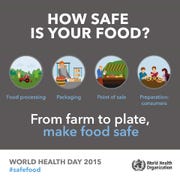World Health Day 2015: From farm to plate, make food safe
April 7, 2015

World Health Organization is highlighting the challenges and  opportunities associated with food safety under the slogan “From farm to plate, make food safe” on World Health Day, observed on April 7.
opportunities associated with food safety under the slogan “From farm to plate, make food safe” on World Health Day, observed on April 7.
According to WHO, new data on the harm caused by foodborne illnesses underscore the global threats posed by unsafe foods, and the need for coordinated, cross-border action across the entire food supply chain.
Worldwide, unsafe food has been linked to deaths of 2 million people each year, with 1,000 of those deaths occurring in U.S.
Last week, WHO issued the first findings from WHO’s Foodborne Disease Burden Epidemiology Reference Group broad analysis of the global burden of foodborne diseases.
The initial FERG figures, from 2010, show that:
there were an estimated 582 million cases of 22 different foodborne enteric diseases and 351 000 associated deaths;
the enteric disease agents responsible for most deaths were Salmonella Typhi (52 000 deaths), enteropathogenic E. coli (37 000) and norovirus (35 000);
the African region recorded the highest disease burden for enteric foodborne disease, followed by South-East Asia;
over 40% people suffering from enteric diseases caused by contaminated food were children aged under 5 years.
Unsafe food also poses major economic risks, especially in a globalized world. Germany’s 2011 E.coli outbreak reportedly caused $1.3 billion in losses for farmers and industries and $ 236 million in emergency aid payments to 22 European Union member states.
Each year, the WHO celebrates World Health Day on the anniversary of the organization’s formation.
Michael Taylor, Food and Drug Administration Deputy Commissioner for Foods and Veterinary Medicine, said World Health Day theme of keeping food safe from farm to table is core of the agency’s mission.
Still, a global supply chain can be challenging, especially as preventive control in food systems can vary from nation to nation.
“As nations we must be strong individually and collectively, working in partnership to apply controls as foods increasingly cross multiple borders to reach foreign markets,” said Taylor.
He added, “What matters is how we, as an international community, achieve high rates of compliance with standards that prevent illness.”
Fortunately, the U.S. has one of the safest food supplies in the world.
Over the last eight years, the U.S. has seen a decrease in the number of foodborn illness with 50,000 fewer reported illnesses since 2007, noted Al Almanza, U.S. Dept. of Agriculture deputy secretary for food safety.
“This decrease is the result of our work to develop innovative ways of educating consumers about safe food handling, our efforts to modernize how we inspect food, and the work we have done with establishments to prevent bacteria from contaminating food,” explained Almanza in his blog. “We (FSIS) are committed to using an inspection system based in science—science that derives from the work of researchers and public health experts. It is important to remember how far we’ve come, but our work is not done.”
Nevertheless, food safety is a shared responsibility from farmers to consumers.
WHO’s Five keys to safer food offer practical guidance to vendors and consumers for handling and preparing food:
Key 1: Keep clean
Key 2: Separate raw and cooked food
Key 3: Cook food thoroughly
Key 4: Keep food at safe temperatures
Key 5: Use safe water and raw materials.
You May Also Like



